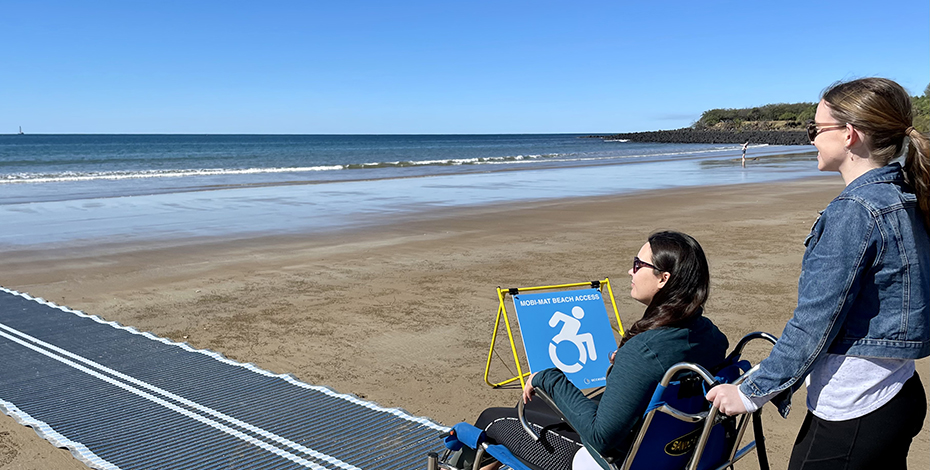
Physio on the beach

Can you help? We are looking for survey participants in a Physiotherapy Research Foundation-funded project investigating beach-based physiotherapy for people living with disability.
Fifteen per cent of the world’s population currently lives with disability and it is considered a global human rights and public health issue (World Health
Organization 2015).
Compared to people without disability, people with disability have poorer self-reported health, poorer mental health, higher rates of chronic illness and shorter life expectancy (World Health Organization 2015, Australian Institute of Health and Welfare 2020).
Nature has a positive impact on human wellbeing and access to the natural environment is an important determinant of health (Twohig-Bennett & Jones 2018).
The beach is Australia’s most popular recreational setting (Maguire et al 2011).
Integral to our lifestyle and culture, it plays host to a number of land- and water-based activities associated with enjoyment, relaxation and interaction as well as improved physiological, psychological and social health and wellbeing (Finlay et al 2015, Ashbullby et al 2013, Lee et al 2020).
Unfortunately, due to challenging terrain, inappropriate access points and inaccessible facilities (Maguire et al 2011, Lee et al 2020), access to beach environments is not possible for many people with disability, who are therefore denied the wide range of health and wellbeing benefits that our beaches offer.
At a community level, increased demand for accessible beaches has been reported (Accessible Beaches Australia n.d.).
However, there is a notable lack of empirical research exploring the therapeutic effects of beach access for people with disability.
There is also limited information about barriers to and facilitators of beach access and about how the beach may be used to promote the health and wellbeing of people with disability.
Aims
Funded by a Physiotherapy Research Foundation Seeding Grant in 2021, this research is being conducted as part of my PhD, in conjunction with Dr Steven Obst and Dr Luke Heales APAM MACP.
The study aims to identify barriers to and facilitators of beach access for people with disability and current practices, benefits, risks, challenges and resource requirements to support the implementation of beach- based therapeutic interventions.
Methods
This study will collect data from Ahpra- registered physiotherapists and occupational therapists with experience in disability, neurological physiotherapy, paediatric physiotherapy, aged care or community practice using a two- step process.
Step 1 is an anonymous 30-question Qualtrics survey informed by the literature and our earlier research findings.
The survey has been peer- reviewed by an expert panel and piloted prior to launch.
It contains multiple choice and short answer questions.
The survey is open until 15 September.
On completion of the survey, participants are invited to register their interest in taking part in an online focus group comprising Step 2 of our research. The HREC number for the study is 23641.
Future impact
Data from the study will be used to improve beach accessibility and to promote inclusivity, health and wellbeing for people with disability.
This research will support the development of an evidence-based model for the implementation of beach-based physiotherapy and occupational therapy interventions for people with disability.
How to participate
If you are an Ahpra-registered physiotherapist or occupational therapist willing to participate in this research, click here for further information and to take part in the survey.
The survey will take less than 20 minutes and the focus group will take 60–90 minutes to complete.
>> Sasha Job APAM is a lecturer in neurological physiotherapy at Central Queensland University and a PhD candidate.
- References
-
[1] World Health Organisation, "WHO Global Disability Action Plan 2014–2021. Better Health for all People With Disability.," World Health Organisation, Geneva, Switzerland, 2015.
[2] Australian Institute of Health and Welfare. (2020). People with disability in Australia [Online] Available: https://www.aihw.gov.au/reports/disability/people-with-disability-in-australia/contents/health/health-risk-factors-and-behaviours
[3] C. Twohig-Bennett and A. Jones, "The health benefits of the great outdoors: A systematic review and meta-analysis of greenspace exposure and health outcomes," Environmental Research vol. 166, pp. 628-637, 2018, doi: 10.1016/j.envres.2018.06.030.
[4] G. S. Maguire, K. K. Miller, M. A. Weston, and K. Young, "Being beside the seaside: Beach use and preferences among coastal residents of south-eastern Australia," Ocean and Coastal Management vol. 54, no. 10, pp. 781-788, 2011, doi: 10.1016/j.ocecoaman.2011.07.012.
[5] J. Finlay, T. Franke, H. McKay, and J. Sims-Gould, "Therapeutic landscapes and wellbeing in later life: Impacts of blue and green spaces for older adults," Health and Place, vol. 34, pp. 97-106, 2015.
[6] K. J. Ashbullby, S. Pahl, P. Webley, and M. P. White, "The beach as a setting for families' health promotion: a qualitative study with parents and children living in coastal regions in Southwest England," Health and Place, vol. 23, pp. 138-47, Sep 2013, doi: 10.1016/j.healthplace.2013.06.005.
[7] D. Lee, J. Kim, B. Thapa, and T. Stein, "Measuring Beach Accessibility for People with Ambulatory Difficulty," The Journal of Park and Recreation Administration, 2020, doi: 10.18666/jpra-2019-9969.
[8] Accessible Beaches Australia. "Accessible Beaches." https://accessiblebeaches.com/
© Copyright 2024 by Australian Physiotherapy Association. All rights reserved.





